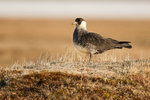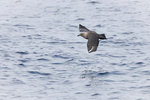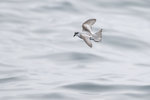


This week we will continue our series on pelagic birds, commonly called seabirds. Liam Hutcheson is again my co-author.
One of the most delightful birds to see out on the ocean are the Storm Petrels. These are tiny seabirds, about 8” long, with a wingspan of about 18”. They get their common name, petrel, from St. Peter as they sometimes appear to be walking on water.
We have two species of Storm Petrels in Washington. The most common is the Fork-Tailed Storm Petrel, a silvery blue-gray bird with a swallow-like flight. The second species is the Leach’s Storm Petrel, a similarly shaped bird with an all-brown body and a white rump patch. Both these birds breed on near-shore islands off the Washington coast, but, ironically, they are seldom seen there. That is because the adults only visit nesting colonies at night. During the day, they are found much farther offshore. Leach’s generally feed over a hundred miles out, whereas Fork-Tailed are usually closer in and therefore seen more frequently.
Another interesting group of offshore birds are the Skuas, gull-like seabirds with seven species forming the genus Stercorarius. In Washington waters, we are fortunate to have an opportunity to see four of these seven, the South Polar Skua, and three species of Jaegers. Away from their breeding grounds they are fish-eaters and are regularly seen harassing gulls, terns, and other birds, robbing them of their fish.
The South Polar Skua is the largest species, about 21” in length; it is a dull-brown bird with white wing patches. These are fascinating birds. They breed in Antarctica and winter off North American coasts. This species is only found offshore and almost never in the Puget Sound.
Jaegers are basically a group of smaller skuas. They all breed in Arctic coastal plains and are found in Washington waters during their post-breeding dispersal. On the breeding grounds, they are hunters (their common name, jaeger, means “hunter” in German), as evidenced by their hooked bills.
Our most common is the Parasitic Jaeger, a handsome bird about 17” in length. It follows tern flocks and regularly steals fish from them. It is commonly found offshore in Washington and the Puget Sound regularly, sometimes coming as far south as Thurston County. Currently, at the Nisqually Delta and elsewhere, there are small flocks of terns passing through our area; there might be a Parasitic Jaeger or two attending these flocks.
Our two other jaegers are Long-tailed and Pomarine. They are also both Arctic breeders, dispersing to the south post-breeding. However, they are much less likely to be found in the Puget Sound. Long-tailed is especially uncommon, only being recorded in our coastal waters in the fall months. The Pomarine Jaeger is the largest and boldest of these three species. It is an aggressive hunter of its breeding grounds, feeding its young primarily on lemmings.
The Jaegers have amazing migrations, breeding in the Arctic and then wintering widely across the Pacific and Atlantic. The Long-tailed species are regularly seen in Antarctic waters. The Parasitic and Pomarine are both more limited in their migrations, flying “only” as far south as the coasts of South America, Africa, Southern Asia, and Australia.
Some readers have asked how Liam and others manage to go bird watching some 40+ miles offshore. In Washington, by far, the best way to see these special and fascinating birds is through the company “Westport Seabirds.” This company has been operating out of Westport for over 50 years and routinely takes trips far out into the open ocean to see these specialized bird species. The trips are led by a team of experienced birders, and captain and first mate, Chris and Phil, are also very knowledgeable. They typically leave from Westport in the early morning, spend about three to four hours motoring out into the deep water around forty miles offshore, and then return that afternoon. For more information, click here to check out their website.
George Walter is an environmental program manager at the Nisqually Indian Tribe’s natural resources department; he also has a 40+ year interest in bird watching. He may be reached at george@theJOLTnews.com
Photos for this column are provided by Liam Hutcheson, a 15-year-old Olympia area birder and avid photographer. He is also the co-author of this column.
1 comment on this item Please log in to comment by clicking here
Wally1912
Thank you for this.
Saturday, October 1, 2022 Report this